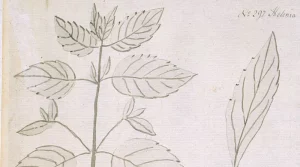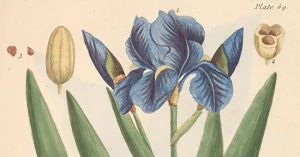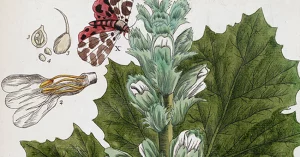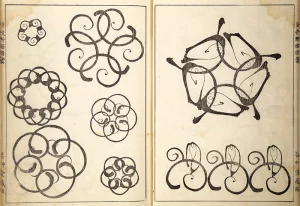Illustrations of British Mycology
In the field of mycology, countless female scientists have helped shape modern understanding of a once misunderstood field. Yet, their invaluable contributions to the sciences often fade into obscurity, overshadowed by their male counterparts.
Anna Maria Hussey (1805—1853) produced an extraordinary work on British mushrooms that significantly contributed to the definition of mycology as an individual branch of biology. Co-illustrated by her sister, Frances Reed, Illustrations of British Mycology, was a two-volume trimuph of artistic labour and scientific discovery.

An extraordinary record of British fungi and female scientific achievement, this volume showcases the pioneering work of Anna Maria Hussey and her visionary approach to art and mycology.
Anna MARIA HUSSEY
Born in the early nineteenth century, Anna Maria Hussey grew up in an era when women’s participation in science was mostly relegated to the margins. Despite the societal restrictions, she developed a keen curiosity for the natural world, particularly fungi—a subject of study that was still in its infancy at the time.
In the early 1830s, Anna Maria married Rev. Thomas John Hussey (1792–1854), a clergyman and Fellow of the Royal Society known for his work in astronomy and meteorology. Their marriage provided her with access to scientific contacts, with the Hussey household becoming a space of intellectual engagement, frequented by scholars and scientists. Their social circles gave her access to a network of people that the learned societies did not provide women at the time, and she cultivated links with leading naturalists of the period.
Hussey began working as a botanical illustrator in the 1840s and, together with her sister, produced numerous illustrations of English mushrooms. She corresponded with figures such as noted mycologist Rev. Miles Joseph Berkeley (1803–1889), discussing fungal classification and ecology, as well as her illustrations. While uncredited, several of her artworks were used as plates in Charles David Badham’s A Treatise on the Esculent Funguses of England (1847).

As a woman in this period, it was nearly impossible to be recognised as a legitimate scientist. The Victorian scientific establishment was notoriously hostile to female contributors, leading to a period of little credit for many working in the field. While the study of botany was a culturally approved discipline for women from the Enlightenment era onwards, they were often excluded from formal training and professional networks, remaining uncredited for any contributions. Accomplished figures such as Hussey and those that followed, like Mary Elizabeth Banning (1822–1903) and Helen Beatrix Potter (1866–1943), made significant contributions to early mycology, producing taxonomies and pathologies that would help establish the discipline.
Hussey’s major independent publication, Illustrations of British Mycology, published in two volumes between 1847–1855, featured 140 coloured plates, accompanied by descriptive and anecdotal text. Approaching the subject from an artistic standpoint, the works presented the study of British botany in a creative and accessible way. Hussey writes in the early days of the project: “I was asked today to state how much I know of Mycology and could only say very little—but I hope to fulfil any promise I make…at any rate I can hold out a hand to guide in shallow waters if I cannot venture into the swell of the Atlantic. I can paint—that I am sure of.” Towards the end of her life, Hussey continued her fieldwork on the study of British mushrooms, but died before the completion of the second volume; which was published posthumously in 1853.

Anna Maria Hussey's Mushroom Illustrations
Though Hussey was never formally admitted to the scientific circles at the time, she positioned herself within the same intellectual landscape as those affiliated with the leading scientific institutions through her correspondence and fieldwork. Now regarded as Britain’s first female mycologist, Hussey’s ability to capture the intricate textures, colours, and structures of fungi was unparalleled. And while her publication was formally unrecognised for its advancements in early mycology, the Linnean Society’s Proceedings from the mid-nineteenth century contain references to fungal species, as described by Berkely and others, many of which align to those found in Hussey’s work, suggesting that it was contributing to the broader scientific dialogue, even if indirectly.
The contributions of women like Hussey reveal a parallel lineage of inquiry—one marked by exclusion, perseverance, and innovation. Bringing a unique perspective to the field, such works present an invaluable archive of fungal taxonomy in the formative years of mycological study. Her research transcended the limitations of the era, helping establish mycology as an independent scientific field, enriching both the historical, artistic, and scientific records for years to come. Despite the societal barriers, the impact of Hussey’s work endured, with Berkley later naming a fungal genus after her, noting his ‘friend, Mrs Hussey, whose talents well deserve such a distinction’—a rare acknowledgement of a woman’s contribution to mycology during the Victorian age.



The Art and Science of Britain’s First Female Mycologist
Related Articles
Discover the Art Meets Science Collection
-
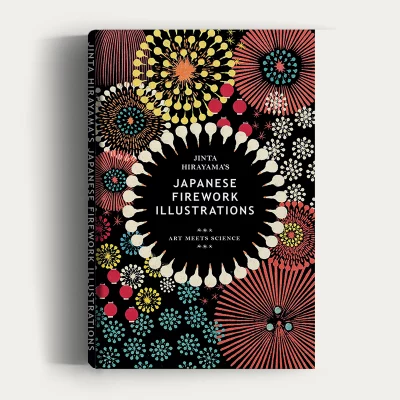 Art/Chemistry/Illustration/Japanese Woodblock/Pyrotechnics/ScienceSelect options This product has multiple variants. The options may be chosen on the product page
Art/Chemistry/Illustration/Japanese Woodblock/Pyrotechnics/ScienceSelect options This product has multiple variants. The options may be chosen on the product pageJinta Hirayama’s Japanese Firework Illustrations
£6.99 – £24.99Price range: £6.99 through £24.99 -
 Nature/Botany/Illustration/Mushrooms/MycologySelect options This product has multiple variants. The options may be chosen on the product page
Nature/Botany/Illustration/Mushrooms/MycologySelect options This product has multiple variants. The options may be chosen on the product pageAnna Maria Hussey’s Mushroom Illustrations
£7.99 – £29.99Price range: £7.99 through £29.99 -
 Art/Color TheorySelect options This product has multiple variants. The options may be chosen on the product page
Art/Color TheorySelect options This product has multiple variants. The options may be chosen on the product pageMunsell’s Colour System
£7.99 – £25.99Price range: £7.99 through £25.99 -
 Art/Astronomy/ScienceSelect options This product has multiple variants. The options may be chosen on the product page
Art/Astronomy/ScienceSelect options This product has multiple variants. The options may be chosen on the product pageUrania’s Star Charts
£7.99 – £29.99Price range: £7.99 through £29.99 -
 Art/Color TheorySelect options This product has multiple variants. The options may be chosen on the product page
Art/Color TheorySelect options This product has multiple variants. The options may be chosen on the product pageEmily Vanderpoel’s Color Problems
£7.99 – £34.99Price range: £7.99 through £34.99 -
 Animals/Butterflies & Moths/NatureSelect options This product has multiple variants. The options may be chosen on the product page
Animals/Butterflies & Moths/NatureSelect options This product has multiple variants. The options may be chosen on the product pageMaria Sibylla Merian’s Metamorphosis
£9.99 – £34.99Price range: £9.99 through £34.99




